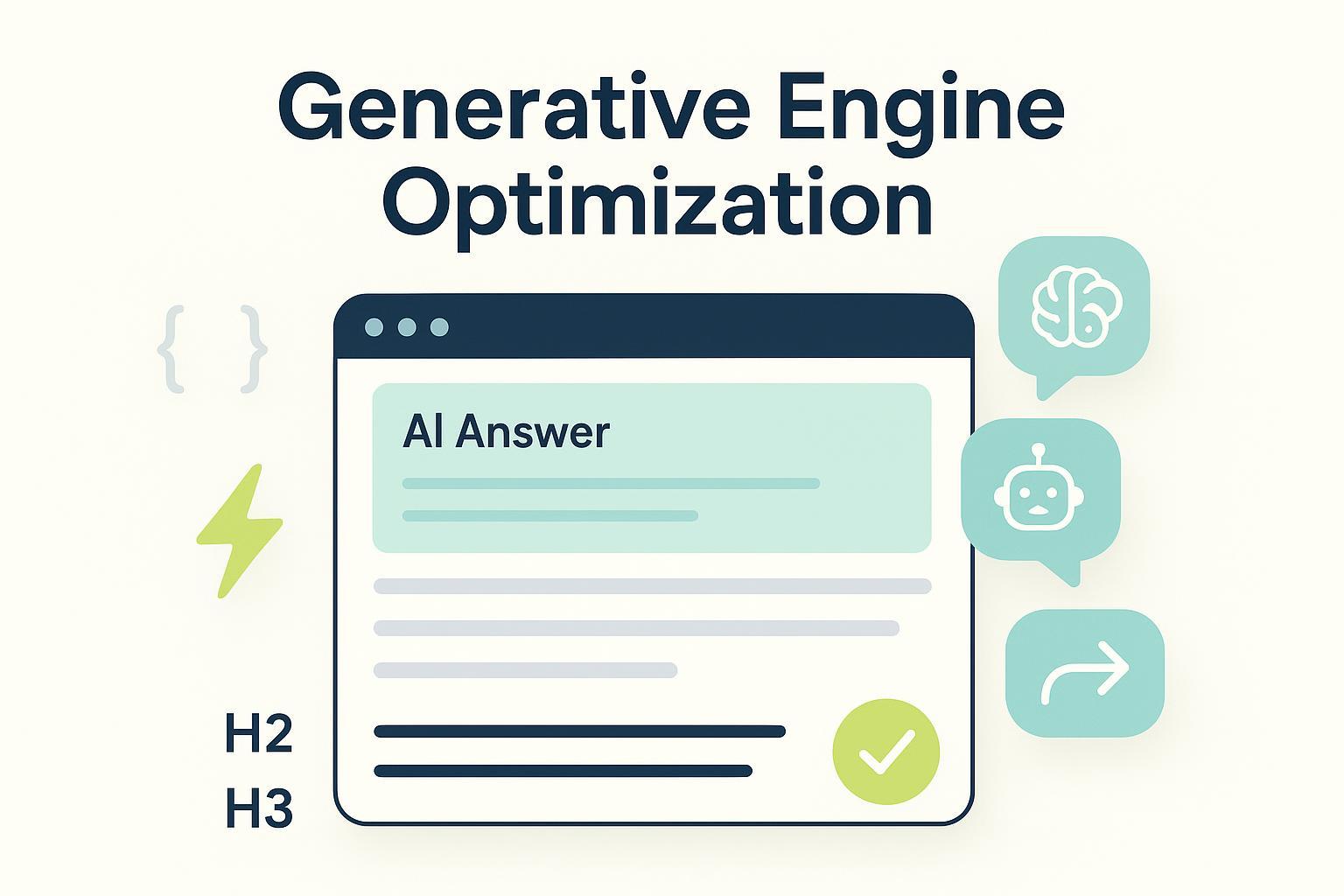What is Generative Engine Optimization(GEO)
Generative Engine Optimization (GEO) enhances content for AI tools like ChatGPT, focusing on clarity and relevance to boost visibility in AI-driven searches.


Generative Engine Optimization helps make content better for AI tools. This improves how often it shows up in search results. Platforms like ChatGPT and Google AI change how people find information. For example, studies show 86.8% of Google searches now use AI features. AI-made answers appear in 77.8% of searches. Tools like ChatGPT are growing fast, with over 100 million weekly users. Businesses must adjust to stay relevant. By focusing on generative AI, your content stays useful and easy to find in today’s digital world.
Key Takeaways
Generative Engine Optimization (GEO) helps AI tools find content easily.
GEO focuses on meaning and usefulness, not just keywords like SEO.
Companies using GEO can build trust with clear and friendly writing.
Testing and updating content often keeps it useful as AI changes fast.
Writing well and avoiding too many keywords keeps readers interested and boosts rankings.
How Generative Engine Optimization Differs from SEO
Focus on traditional SEO: Keywords and search engine algorithms
Traditional SEO helps websites rank higher in search results. It uses keywords, backlinks, and meta tags to follow search engine rules. For years, this method worked with systems that controlled rankings. Experts watch for updates and change strategies to stay visible. But this approach can be slow, causing ranking drops for businesses.
Important measures in SEO include keyword use and link numbers. These focus on matching words to searches and building links for authority. While useful before, this method struggles with AI-based platforms today.
Focus on GEO: Context, relevance, and generative AI platforms
Generative Engine Optimization focuses on context and relevance, not just keywords. It improves content for AI tools like ChatGPT and Google AI. GEO makes sure content matches what users want. Unlike SEO, GEO values clear, organized answers to questions.
AI tools look at content differently. They care about clarity and relevance more than keyword use. For example, Jeda.ai uses prompts to give helpful answers fast. SparkBeyond helped a big Indian bank create custom experiences, boosting customer sign-ups.
Aspect | Traditional SEO | |
|---|---|---|
Optimization Focus | Keyword Matching and Link Building | Content Quality and Presentation |
Key Metrics | Keyword Density, Backlink Quantity | Content Relevance, Citation Prominence |
Content Strategy | Focus on keywords and backlinks | Focus on high-quality, well-presented content |
Differences in user intent and content delivery
User intent is key to understanding SEO and GEO. SEO focuses on matching keywords and ranking high in searches. GEO uses AI to understand what users want and gives better answers.
AI platforms need content that’s clear and easy to read. GEO focuses on organized ideas, not just keywords. This creates more personal and conversational experiences. For example, GEO helps banks use AI to improve customer service and engagement.
Unlike SEO, which depends on keywords and links, GEO values quality and relevance. Good content still matters for rankings, but GEO improves user experience by giving tailored answers.
Why Generative Engine Optimization Matters
The rise of generative AI in search and content discovery
Generative AI is changing how people search and find information. Unlike old search engines that use links, generative AI gives custom answers. Big companies and startups are investing a lot in this technology:
Microsoft works with OpenAI to improve Bing's AI tools.
Startups like Perplexity AI focus on clear and real-time answers.
Generative AI doesn’t just find facts; it creates knowledge based on needs. Businesses that adjust to this change can lead in search and discovery.
Changing user behavior and expectations in the AI era
People now want quicker, more personal answers from AI tools. This shows growing trust in AI systems. A study highlights these new expectations:
Statistic | Value |
|---|---|
75% | |
People thinking AI improves customer service | 53% |
Leaders seeing higher productivity with AI | 44% |
People trusting companies to use AI well | 51% |
Buyers open to AI use | 73% |
These numbers show trust in AI and its value. To meet these needs, make content simple and helpful. Generative Engine Optimization ensures your content fits these expectations.
Opportunities for businesses to stay competitive
Using Generative Engine Optimization gives businesses new chances to grow. As AI changes, so do ways to stay visible and engaging. Companies that adapt can stay ahead:
Optimizing for search engines and AI tools reaches more people.
Adjusting to digital changes keeps businesses competitive.
For example, businesses using ChatGPT and Google AI attract more users. This boosts visibility and builds audience trust. Staying updated ensures your content stays useful in a fast-changing world.
Benefits of Generative Engine Optimization
Better visibility in AI-powered search results
Generative Engine Optimization helps your content show up more in AI searches. Unlike old SEO, GEO makes content clear and useful for tools like ChatGPT. Studies say GEO can boost visibility by over 40% using facts and quotes.
Finding | Description |
|---|---|
Google Rankings | Strong link (~0.65) between LLM mentions and page 1 spots. |
Bing Rankings | Medium link (~0.5–0.6) with LLM mentions, weaker than Google. |
Backlinks | Little to no link with GEO visibility. |
Content Variety | Different formats didn’t greatly improve visibility. |
Visibility Increase | GEO methods raise source visibility by over 40%. |
This shows how GEO makes your content stand out on AI platforms. It ensures your audience finds it easily.
Higher engagement with conversational content
GEO boosts engagement by making content easy to read and friendly. For example, a tech blog used GEO to update a "5G Network Trends" article. Adding new stats and better layout increased Bing Chat traffic by 115%.
Automated replies and personal messages also improve user interest.
Real-time chats let you connect anytime with tailored answers.
Top Conversational Actions | Description |
|---|---|
Two-Way Journeys™ Welcome Message | Greets users and gathers info for personal experiences. |
Automated Replies Post-Purchase | Improves customer experience and suggests related products. |
By focusing on friendly content, you create strong connections. This keeps users interested and coming back.
Staying ahead in a fast-changing digital world
Using Generative Engine Optimization gives you an edge in today’s digital age. Early GEO users say 32% of their top leads come from AI searches. Businesses using GEO improve marketing, visibility, and customer interest.
GEO helps companies stay updated with AI search trends.
It lets marketers make content that works with new search systems.
Studies from Princeton and Georgia Tech show GEO improves visibility and engagement. By using GEO, your business can lead in the AI-driven world.
How to Implement Generative Engine Optimization

Learn how generative AI tools work with content
To make your content better for AI, know how it works. Generative AI, like ChatGPT, studies lots of public data to learn. It can summarize, write code, and even create videos or images. But sometimes, it may show old mistakes or wrong facts.
Always check AI-made content for mistakes or copied ideas. Don’t share private or secret information with these tools. They might not keep it safe. Fix AI content to match your goals and stay trustworthy. By knowing these details, you can make content that works well with AI and your readers.
Write in a friendly and clear way
AI tools like content that sounds natural and easy to read. Write like you’re talking to someone. Use simple words instead of hard ones. Answer questions clearly, like "who," "what," or "where." Adding FAQ sections can also help your content rank better.
For example, don’t say, "Our product offers unmatched features." Instead, say, "Why choose our product? It’s simple and works great for you." This style matches how people talk to AI, making your content more fun and useful.
Organize data to help AI understand better
Organized data helps AI understand your content faster. Clear and neat information makes it easier for AI to find key points. A study showed structured data improved relevance by 82.2% in some cases. Another study found better results using smart algorithms for summaries.
Start by checking how your data is set up now. Clean it up and make it follow AI-friendly formats. Use tools like schema markup to highlight important details on your site. Keep improving your data setup to get the best results. This method makes your content easier to find and use in AI searches.
Regularly check and improve content for AI-generated results.
Testing your content often helps it work better with AI tools. These tools change quickly, so your content needs updates to stay useful. By checking results, you can find problems and fix them to meet user needs.
Key Ways to Test Content
Use clear steps to test and improve your content. These methods show how AI understands and shares your information:
Intent-based Testing: See if AI answers match your goals.
Bias and Fairness Check: Look for unfair or biased responses.
Ongoing Updates: Watch AI systems as they grow and change.
Testing Steps and Actions
Break testing into simple steps. Each step focuses on improving your content:
Testing Step | Action |
|---|---|
First Review | Try the prompt several times |
Compare different versions of the prompt | |
Context Check | Review how AI understands your input |
Goal Comparison | Match results to what you want to achieve |
These steps help you find weak spots and make your content better.
Tips for Better AI Prompts
Fixing prompts is key to getting good answers. Use these tips to improve your prompts:
Make sure prompts are clear and easy to understand.
Try different ways to phrase prompts and compare results.
Study responses to find patterns and areas to fix.
Testing and improving prompts keeps your content helpful for users. For example, testing two versions of a prompt can show which one gives the best answers.
By testing and improving your content often, you keep it strong and useful. This process helps your content stay effective in the fast-changing world of AI searches.
Challenges and Mistakes to Avoid in GEO
Adding too many unrelated keywords
Using too many unrelated keywords can hurt your content's success. This old method, called keyword stuffing, makes text hard to read. Modern AI systems mark such content as spam, lowering your rankings. Instead, use keywords wisely to keep your writing smooth and natural.
Problem | What Happens | How to Fix |
|---|---|---|
Wrong keywords confuse AI, reducing visibility. | Check your keyword use often. | |
Fewer Conversions | Unrelated words lose user interest and trust. | Match keywords to your content's purpose. |
Losing User Trust | Misleading content upsets users. | Focus on clear and helpful writing. |
Avoiding keyword overload keeps your content easy to read and trustworthy. This is key for doing well with GEO.
Missing the importance of conversational AI
Conversational AI works best when it understands tone and context. Ignoring this can lead to bad user experiences. For example, if AI misses emotional cues, it might respond rudely or insensitively.
Skipping conversational AI details can cause emotional mistakes. AI might not notice feelings and reply poorly. This can make users feel ignored or disrespected. For instance, some users said AI sounded rude when discussing serious topics, causing frustration.
To fix this, write content that feels kind and easy to talk to. Match your tone to what the user needs, like help or advice. This builds trust and makes users happier.
Not keeping up with changing AI tools
AI changes fast, and ignoring updates can make your content outdated. Businesses that don’t adjust may fall behind others. For instance, IBM Watson for Oncology struggled because it didn’t match its goals with real-world needs.
Example: IBM Watson for Oncology
Why It Failed: Couldn’t handle the complex needs of cancer care.
Main Problem: Its goals didn’t fit real medical practices.
To stay ahead, train your team and update your plans often. Focus on ethics, set clear rules, and review new tools regularly. These actions help your content stay useful and competitive in the fast-changing AI world.
Generative Engine Optimization (GEO) helps businesses succeed in an AI-driven world. Using GEO improves how often people see your content online. It also makes user experiences better and keeps businesses competitive as search habits change. Studies show AI-friendly content increases sales and builds trust in brands. GEO changes old SEO methods by focusing on what users need most. It delivers clear, useful, and high-quality content. Start using GEO now to keep your content ready for the future and help your business stay strong in a fast-changing digital age.
FAQ
What does Generative Engine Optimization (GEO) aim to do?
GEO helps your content work better with AI tools like ChatGPT. It makes your content clear, easy to understand, and relevant. This helps it show up more in AI-based searches.
How is GEO different from regular SEO?
GEO focuses on context and clear answers instead of just keywords. SEO works to rank high in search engines, but GEO matches content to user needs. This makes it more useful for AI-driven searches.
Why is GEO important for companies?
GEO keeps businesses competitive in the age of AI. It helps your content reach users who want fast and personal answers. This builds trust, boosts visibility, and keeps users engaged with your brand.
Can GEO help increase website visitors?
Yes! GEO makes your content easier to find on AI platforms. By using a friendly tone and staying relevant, it attracts more visitors. This keeps people interested and coming back.
How do I start using GEO?
Learn how AI tools handle content first. Write in a simple, conversational way and organize your information clearly. Use tools like schema markup and test your content often to improve results.





